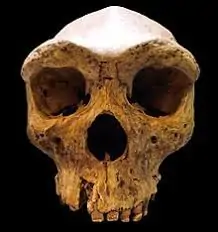Homo erectus origins
East Asians not Out of Africa, after all?
NatGeo is reporting on new research analysis of 4 teeth discovered 1972 and 1983 in the Tongzi county of southern China. They were initially thought to be Homo Erectus. Now new analysis shows they could be Denisovan, a hybrid or some other previously unknown hominid species.
As NatGeo puts it: ”
The find adds to a growing number of fossils from China that don’t fit neatly in the existing human family tree.
Ancient teeth hint at mysterious human relative
One prominent Chinese paleontologist Xing Zhu exclaims “we don’t know where to put it.”
The finds have led two top anthropologists to suggest this may cause a rethinking of Eve Out of Africa, at least for the East Asians.
“We always think of Africa as the ‘cradle of humankind,’” says study author María Martinón-Torres, director of Centro Nacional de Investigación sobre la Evolución Humana in Spain. “I would say it’s a cradle of probably one of the human kinds, which is Homo sapiens.” But many human species once walked the Earth, and what is going on in Asia, she says, is likely “crucial to understanding the whole picture.”
 “I think there’s something separate in China… I think we can say that.”“Asia has been a forgotten continent,” he says. “Its role in human evolution may have been largely under-appreciated. — Chris Stinger, London Museum of Natural History
“I think there’s something separate in China… I think we can say that.”“Asia has been a forgotten continent,” he says. “Its role in human evolution may have been largely under-appreciated. — Chris Stinger, London Museum of Natural History
The new research comes at a time when a near perfectly preserved hominid skull from northern China is getting a second look. The skull is lending credence to the common Chinese anthropologists’ belief in separate origins. Given the more recent date in Asia of 125,000 to 300,000, it raises an intriguing possibility of Homo Heidelbergensis having interbred with modern Homo sapiens in East Asia.
From China Daily, “Fossil skull may hold answers to evolution of human species” Oct. 19, 2018:
“A fossil skull of Homo heidelbergensis, an extinct species of humans, was believed to have been discovered in Northeast China and is considered to be one of the most complete fossils of ancient humans ever found, experts said. This is the first discovery of a Homo heidelbergensis fossil in Asia…
It has important scientific value for studying the origin of humans, considering Homo heidelbergensis is the common ancestor of Homo sapiens, Homo neanderthalensis and Denisovan, Ji said…
According to the university’s article, Homo heidelbergensis fossils found in Africa can be dated to 125,000 to 300,000 years ago, and those in Europe to 200,000 to 600,000 years ago.”
More background from an article in 2016 in Scientific American,
How China Is Rewriting the Book on Human Origins
 Most Chinese palaeontologists — and a few ardent supporters from the West — think that the transitional fossils are evidence that Peking Man was an ancestor of modern Asian people. In this model, known as multiregionalism or continuity with hybridization, hominins descended from H. erectus in Asia interbred with incoming groups from Africa and other parts of Eurasia, and their progeny gave rise to the ancestors of modern east Asians, says Wu.
Most Chinese palaeontologists — and a few ardent supporters from the West — think that the transitional fossils are evidence that Peking Man was an ancestor of modern Asian people. In this model, known as multiregionalism or continuity with hybridization, hominins descended from H. erectus in Asia interbred with incoming groups from Africa and other parts of Eurasia, and their progeny gave rise to the ancestors of modern east Asians, says Wu.
Support for this idea also comes from artefacts in China. In Europe and Africa, stone tools changed markedly over time, but hominins in China used the same type of simple stone instruments from about 1.7 million years ago to 10,000 years ago. According to Gao Xing, an archaeologist at the IVPP, this suggests that local hominins evolved continuously, with little influence from outside populations.
Even CNN admits, the latest finds out of China, particularly dental fossils, are throwing Eve Out of Africa up in the air.
Ancient teeth found in China challenge modern human migration theory
The widely accepted theory of modern human migration, known as “Out of Africa,” is based on available scientific evidence that indicates modern humans originated in Africa and made their first successful migration to the rest of the world in a single wave between 50,000 and 70,000 years ago.
These teeth challenge that theory, both in terms of the timing of the first migration from Africa and whether a different group of modern humans evolved separately in Asia.




god to think how many fossils china had that have been just been turned into folk medicine . sad
Or getting fossil viruses in the meantime.